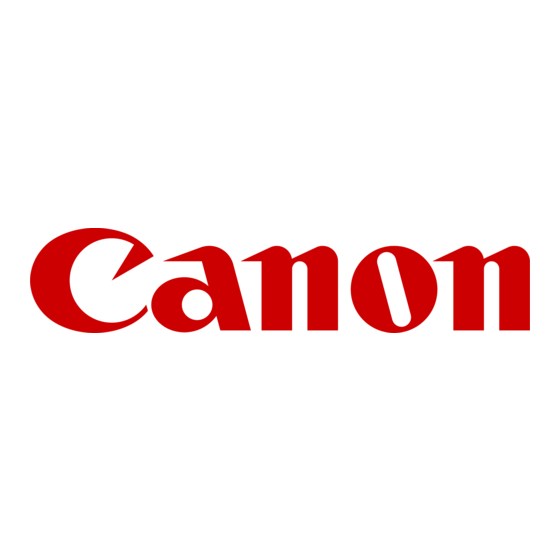- ページ 27
ソフトウェア Canon EOS 350DのPDF 取扱説明書をオンラインで閲覧またはダウンロードできます。Canon EOS 350D 41 ページ。 For windows
Canon EOS 350D にも: パンフレット&スペック (8 ページ), 取扱説明書 (28 ページ), ソフトウェアマニュアル (2 ページ), ソフトウェアマニュアル (2 ページ), ファームウェア・アップデート手順 (6 ページ)

Allows you to select the histogram displayed in the [RGB image adjustment] tab sheet on the
tool palette.
Select [Tone curve mode] (tone curve display), [Interpolation method] (tie method) displayed
in the [RGB image adjustment] tab sheet on the tool palette (p.2-7).
Allows you to select whether the tool palette is displayed as [Docking display]
(within the window) or [Floating display] (another window).
Select a color space for the monitor. If you select the [Monitor profile], click the [Browse] button and
select a profile for the used monitor.
Select a CMYK simulation profile to be used in CMYK simulation. The image is displayed in the
colors of the selected profile and you can simulate the color used when you print in a CMYK
environment such as that of a printer. With this setting, [CMYK] is displayed at the bottom of each
window (p.1-2, p.2-2, p.3-1). The CMYK simulation display can be temporarily canceled in the
edit window (p.2-2) and the edit image window (p.3-1) by holding down the <space> key on the
keyboard.
Select a printer profile to be used for printing images (p.1-19).
Check to preserve [Hue], [Saturation]
and [Sharpness] set for each Picture
Style item (p.2-5, p.2-6).
Select a work color space from
5 kinds of color space.
Select a rendering intent (matching
method) when a printing profile has
been set.
Select a rendering intent (matching
method) when a CMYK simulation
profile has been set.
Select a rendering intent (matching
method) for printing with Easy-
PhotoPrint (p.1-19).
When you restart Digital Photo Professional after changing [Default settings of RGB
Tone curve mode] in the [Tool palette] tab sheet or [Default settings of Work color
space] in the [Color management] tab sheet, the setting content is applied. However,
the setting content is not applied to an image which has been edited before a change
was made (p.1-9 to p.1-12, p.2-6 to p.2-8) and which has a [RGB] mark displayed
(p.1-3). Change an individual tone curve with the menu (p.2-7) that appears by
clicking on the tone curve while holding down the <control> key, an individual color
space by selecting the [Adjustment] menu
[Work color space] (p.1-9).
To select a monitor or printer profile, you need to have previously installed the monitor
and printer profiles to be used on the computer. For details on the monitor and printer
profiles to be used, refer to the user manual of each device.
The specified color space is added to the ICC profile that is embedded in TIFF or
JPEG images that have been converted from RAW images and saved (p.1-15, p.1-
16).
A color space is the reproducible color range (the characteristics of color gamut).
Digital Photo Professional supports the following 5 kinds of color space.
sRGB
: Standard color space for Windows. Widely used for the standard
color space of monitors, digital cameras, and scanners.
Adobe RGB
: A wider color space than sRGB. Mainly used for printing for
business purposes.
Wide Gamut RGB : A wider color space than Adobe RGB.
Apple RGB
: Standard color space for Macintosh. A slightly wider color space
than sRGB.
ColorMatch RGB : A slightly wider color space than sRGB. Mainly used for printing for
business purposes.
You can select a rendering intent (matching method) from [Perceptual] or
[Colorimetric] for color conversion when printing an image.
Perceptual
: Matching method generally suited to natural images such as
photographs which minutely expresses intermediate colors such as
skin tones and the blue of the sky.
Colorimetric
: Matching method generally suited to graphic-type images such as
photographs which expresses an image in the vivid primary colors
of red, blue and yellow.
With [CMYK simulation profile], you can simulate the color used when you print in a
CMYK environment such as that of a printer. Digital Photo Professional is compatible
with the following 4 types of printing profiles.
Euro Standard v1.00 : Profile normally used for book printing in Europe, suitable for
simulation of standard European printing.
JMPA v1.10
: Profile normally used for book printing, etc. in Japan, suitable for
simulation of magazine advertising standard color printing.
U.S. Web Coated v1.00 : Profile normally used for book printing in North America, suitable
for simulation of North American standard printing.
JapanColor2001 type3 : Profile becoming a standard in the Japanese printing industry,
suitable for simulation of JapanColor standard printing.
Cover/Table of
Contents
Introduction
Displaying Thumbnail Images
1
and Performing Basic Edits
in the Main Window
2
Performing Detailed
Edits in the Edit
Window
3
Performing Detailed
Edits in the Edit
Image Window
Displaying an
4
Image in the Quick
Check Window
5
Reference
Index
1-21
